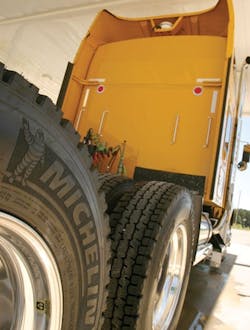The October edition of CTD examined trends in trailer tires. Two months prior, CTD looked at steer tires. In this edition, we examine trends in drive tires.
Gas prices may have come down in recent months, but the price of diesel remains relatively high and is expected to budge very little, at least downward.
“I think the high price of diesel is here to stay,” says Ron Gilbert, director of commercial products for Toyo Tire U.S.A. Corp.
He’s not alone in his thinking. Fleets and owner-operators are of the same mindset. Fuel economy is the name of the game in commercial truck tires, regardless of position. Drive tires are now expected to contribute to improved fuel efficiency every bit as much as trailer and steer tires.
“The movement toward fuel economy has been very dramatic,” says Clif Armstrong, director of marketing for Continental Tire North America Inc. Fleets are even sacrificing mileage to gain fuel economy, he reports.
“Even if diesel stays where it is today, fleets can save more money in fuel efficiency than they could ever recoup in miles. Fuel efficiency is at the forefront. It’s a hot topic and it’s an immediate fix for operational costs.”
Drive tires can contribute to greater fuel efficiency if a number of factors are present, say tire manufacturers. One of the first considerations is correct tread depth. “Going back three or four years, everyone was going deeper in terms of tread,” says Brian Sheehey, director of commercial tires, Hankook Tire America Corp. “Tread depth of 30/32nds was the big thing.”
That’s as far as Hankook will go, according to Sheehey, who believes that 26/32nds and 28/32nds “are good” for fuel economy.
[PAGEBREAK]
He explains that it’s critical to make sure tread depths are consistent from tire to tire. This includes matching duals correctly. “You often see incorrect matching in fleets that don’t have good maintenance practices. Large fleets do a better job because they have subsidized tire programs, whether in-house or outsourced.”
Inflation, of course, plays a major role in fuel economy. Some trucking companies are of the belief that a single inflation level works well across-the-board, says Sheehey. “A lot of them have a standard matrix of 100 psi, but inflation should be directly related to load. Is a truck carrying 80,000 pounds all the time? No.”
Beyond an effort to achieve lower rolling resistance, what other trends are affecting drive tires?
Many fleets continue to want aggressive-looking tread patterns, says Guy Walenga, director of engineering, commercial products and technologies, Bridgestone Firestone North American Tire LLC. “They’ve gotten used to it and they like it.”
Drive tire tread patterns “are typically more aggressive,” according to Tim Miller, marketing communications manager, commercial tires, Goodyear Tire & Rubber Co. Wider grooves also are prominent. “If you encounter snowy or slushy roads, you need something that will provide better traction,” he says.
Moving ahead, reducing cost-per-mile through greater fuel economy will be the objective of fleets and private truckers, says Walenga.
“As you get more drive tires in the marketplace, you’re going to see an overall improvement in rolling resistance.” This will appeal to small fleets and owner-operators, in particular. “If a big fleet can get a fuel surcharge, they can recover some costs. Small operators don’t always get that surcharge, so they’re looking for more ways to achieve better fuel economy.” ■
The return of ribs? Some fleets are looking at rib-type tires
“Deep lug drive tires have been the norm,” says Ron Gilbert, director of commercial products for Toyo Tire U.S.A. Corp. “The last few years the drive tire standard has been 30/32nds.
“However, we’re seeing more fleets — especially in the Sun Belt — that are looking at going back to rib-type tires for the drive position. But deep lug drive tires are still out there, so the trend is not going to change overnight.”



